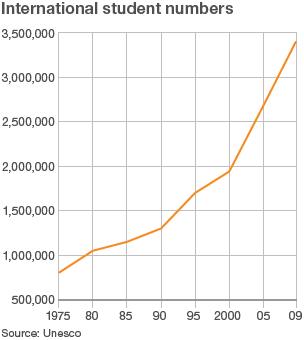Record numbers of international students
- Published

The number of international students around the world is continuing to rise sharply, with provisional figures from Unesco's Institute for Statistics revealing an annual increase of 12%.
The final figures for 2009, to be published in May, are expected to show the number of international students rising to 3.43 million from 2.96 million, according to the Unesco statistics.
There are many different measures of overseas students - but this global figure from Unesco shows a huge spike in numbers this decade, rising by more than 75% since 2000.
The United States is the biggest destination. According to the Institute of International Education, the latest figures show there are 691,000 students in the US, with an annual value to the economy estimated at around $20bn (£12.3bn).
But its dominance now depends on the ever-growing number of arrivals from China, overtaking India as the largest single group of overseas students. The number of Chinese students in the US rose by almost 30% in a single year. The third biggest contingent in the US comes from South Korea.
China has become the firecracker in this market. There are more than 440,000 Chinese students abroad - and there are plans to rapidly increase the number of overseas students coming to China's universities, with an ambitious target of 500,000 places.
To put this into a longer-term perspective, the entire overseas student population in China could once have travelled in a minibus. In the early 1950s it consisted of 20 east Europeans.
Chasing quality
Driving the demand among Chinese to study abroad is a shortage of places on high-quality degree courses at home and the pressure to have an overseas qualification when chasing jobs, says Rahul Choudaha, associate director of the New York-based World Education Services.

Sign of the times: The expanding Chinese economy is drawing overseas students to Shanghai
The Chinese university system has expanded in terms of quantity, says Dr Choudaha, but it is struggling to keep pace with the demand for quality.
The plan to bring more overseas students into China is part of the country's drive to internationalise its economy and become a "knowledge power", says Dr Choudaha.
It's also a reflection of how much the culture of the overseas student market has changed - with western universities no longer able to depend on their pivotal position.
It was once a trade as stately as steamships, vaguely colonial in how it managed to make a nice little earner seem rather philanthropic.
Now it's more like international air travel, with the trade routes of this multi-billion business wrapping themselves around the globe in every direction.
The current intake of overseas students in China also shows a different kind of map of influence. The only European country in its top 10 is Russia - with the most overseas students in China coming from South Korea, the US, Japan, Thailand and Vietnam.
Overseas without the travel
It's also no longer necessarily about overseas students travelling from overseas.
Figures released by the British Council this week show that there are now more "overseas students" taking UK degrees in their own countries than there are overseas students coming to study in the UK.
The UK is the second biggest destination for overseas students.
But there are now 340,000 students taking UK university courses in their home countries, either through partnerships between UK and local universities or else through UK universities setting up branch campuses, such as Nottingham in Ningbo in China.
More than 160 branch campuses have been opened in more than 50 countries - mostly by US universities. There are also a multitude of partnerships and joint degrees as part of this academic cross-pollination.
According to the British Council, this type of "transnational" studying has increased by 70% in a decade.
The council's chief executive, Martin Davidson, says this is going to appeal to "students across the world who may not be able to afford to spend several years thousands of miles away from home".
Technology can only accelerate this process. Online degrees are making strides in the mainstream, with US firms such as Laureate teaming up with institutions such as Liverpool University to offer internet-based courses. Laureate has a network of university links in 24 countries.
Talent search
Another key to this growth in internationalisation is the competition for the most talented students and staff.
Major research institutions are like top football clubs, operating in in a kind of international zone, judged by international comparisons and competing to recruit the best individuals from around the world.

Students in Berlin: Universities have international catchment areas
Massachusetts Institute of Technology (MIT) is widely-recognised as one of the best research universities in the world.
It might be physically based in Boston, but its cutting-edge postgraduate courses depend on recruiting the best students - and this means a global rather than a national catchment area.
About 40% of the students on graduate courses are from outside the US, says Danielle Guichard-Ashbrook, director and associate dean of the International Students Office.
"We open up admissions to the whole world. We don't consider their nationality, we just want the best - and we get them," she says.
There are more than a hundred different nationalities represented in the graduate intake - with the biggest numbers coming from China, India and South Korea.
Cash cows
The scale of the increase in international student numbers in university is not without risks.
In the UK, the current level of anxiety over proposed student visa restrictions reveals how much universities have come to depend on the income from overseas students.
Steven Schwartz is vice chancellor of Macquarie University in Sydney, having previously worked in universities in the UK and US.
In Australia he has seen how quickly an expanding overseas student market can evaporate.
Indian public opinion was outraged after a series of attacks on Indian students in Australia in 2009. Applications from Indian students slumped by 50% - and threatened an industry which had grown to become Australia's third biggest export.
He says the lesson from this rise and fall is that university systems should always remember that students are individuals rather than walking fee cheques.
"Studying with students from diverse backgrounds, domestic students learn about other cultures, cuisines and languages. They also learn about fairness and tolerance and teamwork and fair play. These lessons are just as important as any learned in class," says Prof Schwartz.
"However these lessons will be negated when we treat international students as simply income sources. No student wants to be an export earner and the sooner we learn this the better."